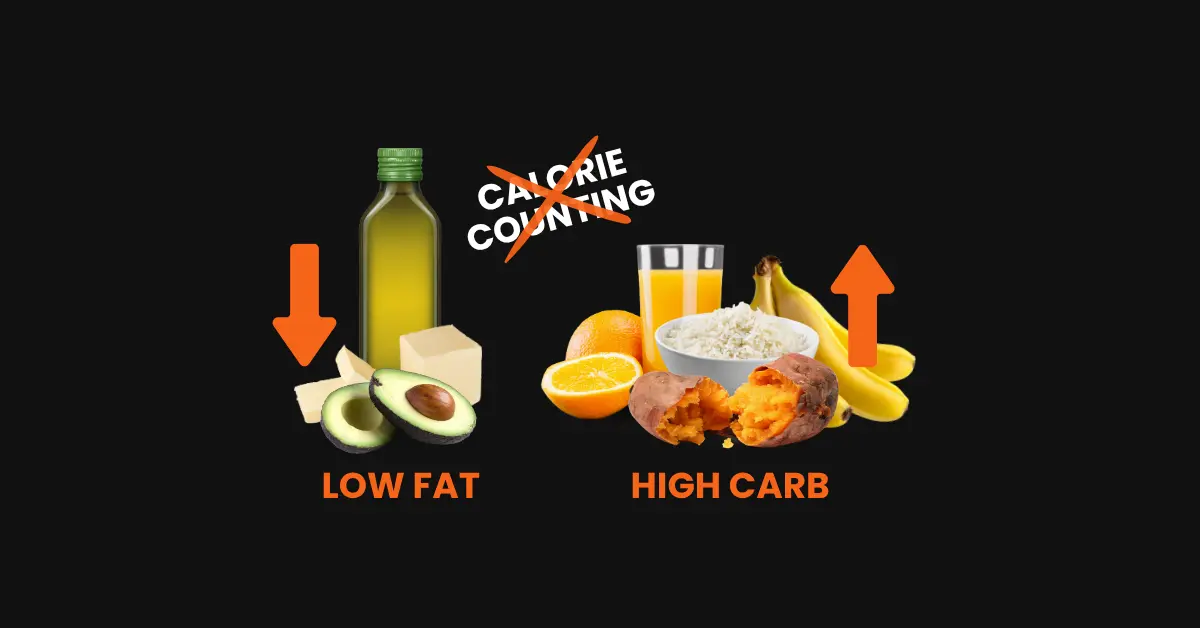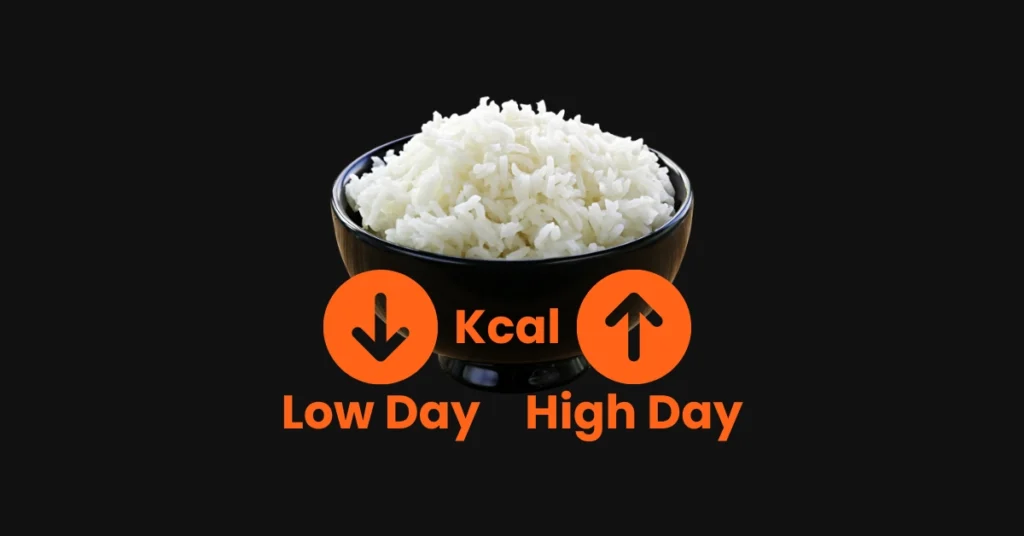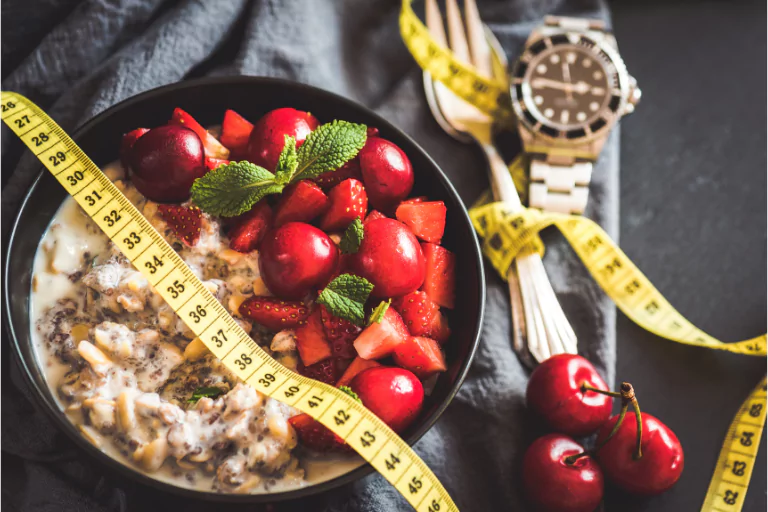How to use A Low Fat diet for fat loss without Tracking Calories
key takeaways
Macronutrient Tracking vs Restricting Dietary fat

To lose body fat, some form of dietary restriction will need to be in place to create a calorie deficit. This is because a negative energy balance will need to be maintained over a period of time to lose body fat. To do this, we can track our macronutrients and calories precisely, or we can heavily restrict one of the energy macronutrients, such as dietary fat. In doing this, we are essentially doing the same thing: reducing the amount of calories we are consuming each day.
Benefits of tracking macronutrients
Tracking macronutrients (carbohydrates, protein, and fats) is a highly effective strategy for fat loss and is widely used within the fitness industry and by physique athletes such as bodybuilders, who need to get to advanced levels of leanness. The advantage of tracking macronutrients is that calories are also tracked, since each macronutrient has a specific number of calories per gram. This means we can lose body fat with different macronutrient ratios, as long as we are tracking accurately and are maintaining a calorie deficit.
Using this approach, we can lose body fat using more of a mixed macronutrient diet, consuming a moderate amount of carbohydrates and dietary fat. Carbohydrates and dietary fat will still need to be reduced somewhat to keep calories low enough to maintain a calorie deficit, especially as a diet phase progresses. When using more of a mixed macronutrient diet, there is more room for error if we do not track our macronutrients. Consuming more dietary fat with higher amounts of carbohydrates can easily result in our calories creeping up, resulting in limited or no fat loss at all.
Although it is possible to lose body fat without counting calories using a mixed dietary approach by implementing specific nutritional and lifestyle strategies, more experience is needed to pull this off. This is why restricting a specific macronutrient such as dietary fat can be a highly effective strategy for fat loss when an individual does not want to track their calories and macronutrients. By keeping dietary fat low, it is much easier to maintain a calorie deficit without tracking.
Benefits of restricting dietary fat
Since dietary fat has over double the amount of calories per gram compared to carbohydrates and protein, restricting dietary fat will significantly lower the amount of calories we are consuming. Over-consuming dietary fat and therefore calories is far easier to do when we are not tracking our macronutrients and calories, compared to carbohydrates, which are generally more voluminous. It is also far easier for the body to store dietary fat if we over-consume calories compared to carbohydrates, which require a number of steps in order to be stored as body fat.
When dietary fat is low, carbohydrates can remain high while still maintaining a calorie deficit. This is great for overall energy levels and can even help with the calories-out part of the energy balance equation. Many people find that when carbohydrates remain high, they have more energy not just to train hard in the gym but also for everyday life. They are more likely to move more throughout the day and they also have more energy for other activities such as cardio. Maintaining a high level of non-exercise activity thermogenesis (NEAT) is important during a fat loss phase; the more we move, the more calories and nutrients we can consume while losing body fat.
Carbohydrates are also great at keeping stress hormones such as cortisol in check, which may increase when consuming fewer calories and especially carbohydrates and training hard in the gym. Chronically elevated levels of cortisol will make it harder to lose body fat and will also increase the risk of muscle loss during a fat loss phase. Carbohydrates are also positively correlated with maintaining healthy thyroid levels and hormonal health in general, such as high testosterone levels in men.
how to set up a low fat diet

Although we are not tracking macronutrients, it is a good idea to have a rough idea of dietary fat levels, as this will need to remain low. We should also be consuming adequate daily protein to help maintain muscle and help with satiety during a fat loss phase. Entering the foods we will be eating into a food tracking app initially and then checking back occasionally, especially when we change something in our diet is also good idea.
By keeping dietary fat low, hitting somewhere around our protein target, having a rough idea of our daily carbohydrate intake, and monitoring our scale weight, we can lose body fat without daily food tracking. Eating similar or even the exact same foods as recommended in our complete fat loss guide can further simplify the process.
Keep Dietary fat low
The amount of dietary fat consumed will depend somewhat on the individual. Our recommendation is to consume no more than 50 grams of fat per day. We find 40 grams or lower works great for most people. We would not recommend going lower than 30 grams per day. Keeping dietary fat this low keeps calories low and provides a degree of buffer or margin of error when we do not know the precise amount of carbohydrates and calories we are consuming each day. Some days we may be eating slightly more calories and some days slightly less; however, it is highly likely that we will be maintaining a calorie deficit throughout the week, and will therefore lose body fat.
Dietary fat is important for hormonal health, and trying to maintain a low-fat diet permanently is likely not the best idea. With this in mind, it is important to understand that a fat loss phase is only maintained for a relatively short period of time and is used for the specific purpose of reducing body fat. On completion of a fat loss phase, we recommend increasing dietary fat a little, although you could still maintain a high-carb, low/moderate fat diet to maintain your body weight or even increase your body weight in a muscle-building phase.
keep protein moderate
Aim for around 1 gram of protein per lb of goal body weight. You can experiment with a slightly lower protein intake; however, we find keeping protein a little higher can help with satiety. The benefit of lower a lower protein intake is that you have more room for carbohydrates. You can also experiment with eating a little more protein as long as this does not mean you are reducing carbohydrates too much. We are aiming for a high-carbohydrate, low-fat, moderate-protein diet.
keep Carbohydrates high
The rest of your calories will come from carbohydrates, which could be 60% or more of your calories. Keeping dietary fat low and protein moderate will leave plenty of room for carbohydrates while still keeping calories low enough to maintain a calorie deficit. This could be anywhere from 250-300 grams of carbohydrates for the average man at the beginning of a fat loss phase. Larger individuals and those with a high level of daily activity may be able to start on an even higher amount of carbohydrates. Smaller individuals and especially smaller women may need to start a little lower.
Although we are not tracking our carbohydrates precisely in terms of grams per day using a food tracking app, we should still try to quantify or have a rough idea of the amount of carbohydrate foods we are consuming each day. Eating the same or similar carbohydrate sources each day can make this process even easier. We can then adjust the amount of carbohydrates we are consuming each day depending on whether our body weight is tracking down over time.
It is important to understand that with dietary fat already low and protein set at around goal body weight, carbohydrates will still need to be reduced somewhat over the course of a fat loss phase in order to reduce calories and continue to lose body fat. The amount of carbohydrate restriction will depend on the level of leaness an individual is aiming to achieve, as well as their size and activity level. The good news is that with this high-carb approach to dieting, energy expenditure can remain high, which can allow most individuals to keep their carbohydrates relatively high throughout the majority of their fat loss phase.
food choices

Choosing the foods which work well for you, the ones you enjoy eating, and the ones you can be consistent with over time is important, whichever dietary approach you are following. The overall quality of the foods you are consuming is important, especially when we are consuming fewer calories and therefore fewer nutrients. Eating mostly minimally processed, nutrient-dense, whole foods is key.
It may even be best to consume these types of foods all of the time if we are not tracking the precise number of calories and macronutrients we are consuming each day. Most processed foods will include carbohydrates and dietary fat together, which can make it difficult to keep your fat grams low for the day. The calories and macronutrients listed on labels can also be inaccurate, meaning you may be consuming more calories and especially dietary fat than you think.
Lean protein
Most protein sources come with some dietary fat, some more than others. For this reason, we need to be selective in choosing our protein sources. This will allow us to consume adequate daily protein to maintain or even build muscle in a fat loss phase without over-consuming dietary fat. This is even more important when we are heavily restricting dietary fat to keep carbohydrates high while keeping calories low. Choosing lean protein sources with minimal or no fat at all is key. A good rule of thumb when selecting a protein source is that for every 20 grams of protein, it should include no more than 5 grams of dietary fat.
Here are some of the best lean protein sources to include when following a high carbohydrate low fat diet:
Fruit
Fruit is a great option, delivering a source of easily digestible, nutrient-dense carbohydrates. It’s our recommended carbohydrate source to make up the majority of carbohydrates for most people, especially during the daytime. Although fruit is a simple sugar, it will not spike blood sugar as much as eating starch, due to the combination of fructose and glucose, compared to starch, which is pure glucose.
This makes it a great option to eat during the daytime as it does not cause as much of a rise and drop in blood sugar, which can make some people feel sleepy. Most people feel lighter and more energised eating more fruit during the daytime and may have more mental clarity than if they were eating starch. It can also be a better option to use pre-workout for many people. Another great benefit of fruit is convenience. It is far easier to use fruit as a carbohydrate source for people who work a 9-5 job, and they can easily grab some if they did not bring some to work with them.
Here are some of the best sources of fruit to include in your diet:
Starches
Certain starches can be a great source of carbohydrates, especially if an individual is highly active, and needs to eat a higher amount of carbohydrates. This is because starches are a more dense source of carbohydrates compared to fruit, which can make it easier to consume large amounts of carbohydrates compared to eating just fruit alone. The downside is they can make some individuals feel a little heavy and even sleepy and are therefore best eaten at certain times of the day. This is not necessarily the case for all individuals so some experimentation may be needed to see what works best for you.
Many people do well eating starches towards the end of the day, such as with their evening meal, when they are not as active, and this can even help them relax and wind down for the day. Some individuals seem to do better eating slightly more starchy carbs compared to more fruit, and for some, it is the opposite. Most people will do well eating a combination of starch and fruit, and will eventually find the ratio that works best for them.
If you feel you need more starch, you can also use a combination of starch and fruit in a meal. This way, you are able to consume a more energy-dense source of carbohydrates without spiking your blood sugar too much. This can be a great option if you choose to eat starch during the daytime. It is also important to choose starches that work well for you, as certain types can be problematic for some individuals, compared to fruit, which almost everyone does well on. Well-cooked, easy-to-digest starch sources work best for most people. If any foods are causing you digestive issues or discomfort, they are best avoided.
Here are some great options for starchy carbohydrates to include in your diet:
Vegetables
Fibrous carbohydrates such as leafy greens and cruciferous vegetables can be considered a fibre source. Although these types of vegetables contain carbohydrates, they are not an energy-dense source of carbohydrates. These can be used for some or all meals, and due to their high volume, low calorie content, are great to use during a fat loss phase to help with satiety. The fruit-type vegetables such as tomatoes, cucumbers, and peppers are also a great option.
Added Fats
Since we are restricting dietary fat, adding extra dietary fat to meals will not be required in most situations and for most individuals. Dietary fat will be present in most foods and will add up throughout the day, even when using lean sources of protein and other low-fat foods, although this may depend somewhat on the number of meals eaten. To keep dietary fat low, 30-40 grams per day for most people, adding minimal dietary fat or none at all to meals will be required. Any additional fat will likely need to be minimal, for example, 1-2 teaspoons of olive oil, if your protein source is zero fat.
meal frequency

Eating three meals per day works great for most people during a fat loss phase, as this allows for larger, more satisfying meals compared to eating more meals when consuming fewer overall daily calories throughout the day. We consider a meal to be a complete meal consisting of a lean protein source, a carbohydrate source, and a small amount of dietary fat. With that said, eating low fat with moderate protein leaves plenty of room for carbohydrates, especially if we are more active. Snacking on a non-fat carbohydrate source such as a piece of fruit between meals can be a great option to help with hunger during a fat loss phase.
Another good option could be to include an extra protein feeding for the day if desired, or if needed to hit a protein target for the day. This could be something like a zero-fat, high-protein Greek yoghurt as a last snack of the day, or post-workout if you know you will not be eating a complete meal for some time. Protein shakes are also an option, although liquid protein is not as satiating as real food, which is something to think about during a fat loss phase when hunger levels will be elevated.
We generally recommend eating three meals per day during a fat loss phase for most individuals. Eating three meals per day allows for more frequent carbohydrate feedings, which can help keep stress hormones such as cortisol under control during a fat loss phase. It will also allow for three protein servings per day, which may be beneficial for maintaining muscle during a fat loss phase and will also help with satiety. With that said, some people do great with eating two meals per day, and this may be a better option for some people if it is a better fit with their current lifestyle and improves dietary adherence. This can also work well with intermittent fasting for some individuals.
The advantage of eating two meals per day is that dietary fat can be a little higher with each meal, which means we have a little more freedom with some of our food choices. An option that can work well for some people is to eat a complete meal for breakfast and a complete meal for dinner. Fruit can be eaten during the day if desired to help with satiety. This can be a great option for people who work a 9-5 job and cannot or do not want to eat a complete meal during the day.
high carb low fat dietary Strategies

There are a few useful dietary strategies that can work well with a high carb, low fat diet. Some or all of these can be implemented depending on the situation, the individual, and personal preference.
higher fat days
Including a higher-fat day once per week or when you think you need one can be a great option when following a high-carb, low-fat diet. When dietary fat is heavily restricted, certain food choices are unavailable, and some individuals may have cravings for some higher-fat foods. The body is intelligent, and listening to the signals it sends can be a good idea. If you are craving some higher-fat food, it may be an indication that your body requires a little more dietary fat. A higher fat day is a good opportunity to consume some more of the fat soluble vitamins, A, D, E, and K, which come with higher fat foods.
As mentioned previously, we do not recommend heavily restricting dietary fat in the long term. We are simply using this dietary strategy for a short duration of time and for the specific goal of reducing body fat while keeping carbohydrates high. With that said, if you feel you need to, increasing dietary fat for a day can be a good option. It is important to increase dietary fat to a moderate level and not go overboard. Eating excess dietary fat increases calories significantly, which can easily result in your average weekly calories remaining at maintenance, resulting in no fat loss.
Carbohydrates will need to be reduced a little on higher-fat days, depending on how much dietary fat you are consuming. This will allow you to remain in a calorie deficit. Placing a higher-fat day on a non-training day is a good option.
using fruit to control hunger
The benefit of keeping dietary fat low is that we have far more room for carbohydrates, especially if we are keeping our exercise and daily activity high. Snacking on a piece of fruit between meals will not significantly add to the amount of carbohydrates and calories we are consuming throughout the day. This can reduce hunger levels a little, and fruit is a great source of easy-to-digest carbohydrates that can provide a little bit of extra energy when needed.
Sometimes all that is needed is a little bit of fruit to raise blood sugar and reduce hunger. Since fruit contains a balance of glucose and fructose, with potassium, fibre, and water, it will not significantly raise and then drop blood sugar, in the absence of protein and dietary fat, as can be the case when eating starch on its own.
intermittent fasting
We do not recommend intermittent fasting for everyone, and the benefits and potential downsides should be taken into consideration depending on the individual and their current situation. Intermittent fasting can work well for some people and can be a good fit for a high-carb, low-fat diet. If you are going to use intermittent fasting, we recommend a specific protocol if you have body composition goals, such as building or maintaining muscle while losing body fat.
refeed days
Refeed days can be used when following a high-carb, low-fat diet during a fat loss phase if needed, as with any other dietary approach. Refeed days involve raising calories to around maintenance for one or two days per week, usually by increasing carbohydrates. Since carbohydrates should be relatively high, adding in some extra dietary fat along with carbohydrates to bring calories up is a good option. The difference between a higher-fat day mentioned previously and a refeed day is that on higher-fat days a calorie deficit is still maintained because we are reducing carbohydrates.
Diet breaks
Breaking a fat loss phase into blocks separated by periods of one to four weeks where calories are raised to maintenance can be a good option for some people, although this is not always necessary. They can be planned or auto-regulated, meaning they are taken when an individual feels they need one. Using diet breaks will allow dietary fat to be increased for a period of time, which can be beneficial for individuals who have been restricting dietary fat for some time, for example, individuals who have a significant amount of body fat to lose and need to diet for longer.
Tracking Bodyweight

Although we are not tracking our macronutrients and calories, we still need to track our body weight. Collecting real-world data, such as trends in body weight over time, will allow us to see if we are heading in the right direction in terms of weight loss. We can then make adjustments if needed by reducing the number of carbohydrates we are consuming each day, depending on the data we collect. If we do not collect real-world data, we risk wasting weeks or even months of no fat loss progress if we are consuming too many calories.
We recommend weighing yourself each morning and collecting a 7-10 day average weight and comparing it to the previous period. This removes daily fluctuations in body weight and provides a more accurate picture of trends in body weight. Weigh yourself every morning, upon waking, after using the bathroom, and before eating. You can learn more about collecting real-world data such as body weight, body part measurements, and taking pictures in our complete guide to fat loss.
strength training

The cornerstone of any successful fat loss phase involves strength training to maintain or even build muscle during a fat loss phase. Following a well-structured training split appropriate for your level of advancement, and performing the correct volume, intensity, and frequency is key. Some great options include full body and the highly effective upper body, lower body training split. To learn more about what it takes to build muscle, you can check out our complete guide to building muscle. Understanding and applying these principles will also allow you to maintain muscle during a fat loss phase. The things that help you build muscle will also allow you to maintain muscle during a fat loss phase.
Lifestyle

Understanding certain lifestyle principles and applying them consistently over time will greatly improve the results you are likely to achieve for fitness goals such as building muscle and losing body fat. Keeping activity levels high can assist fat loss and mitigating stress as much as possible, while getting consistent, good-quality sleep is important. This is especially true during a fat loss phase when the body is under increased stress from a reduced calorie intake combined with hard training in the gym to maintain or build muscle.
keeping daily activity high
A major benefit of keeping carbs high during a fat loss phase is that people usually report having more overall energy, compared to people who choose to follow a lower carbohydrate, higher fat diet. Maintaining high energy and activity levels during a fat loss phase is vital as this allows people to diet on higher calories, which is always a better option than overly restricting calories. With more carbohydrates in the diet and therefore more energy, people will generally move more throughout the day, keeping their non-exercise activity thermogenesis (NEAT) high. This is important because it is well known that this reduces when people are consuming fewer calories, as the body subconsciously tries to preserve energy.
By keeping daily activity high, we are effectively increasing the energy out part of the energy balance equation, and by consuming more carbohydrates, we are more likely to move more or even seek out activities outside of the gym that increase the number of calories we burn each day. Having a daily step count and walking more is one of the easiest and simplest ways to increase daily activity. We recommend 10-12k steps per day or up to 15k if you have more time. Walking is a great low-intensity activity to assist in fat loss, and is not overly stressful on the body, meaning it will not interfere with your strength training.
cardio
Cardio is not always necessary in the context of simply fat loss. Some individuals can achieve a decent level of leanness with no cardio at all, and some people may even be able to reach advanced levels of leanness with no cardio at all. With that said, almost everyone who achieves decent levels of leanness, such as 15% body fat or below, will at least maintain a good amount of daily activity in the form of walking and hitting a high number of daily steps, which could be considered zone 1 low-intensity cardio. The benefit of performing cardio during a fat loss phase is that we can maintain a calorie deficit and lose body fat while consuming more calories.
When we keep dietary fat low and carbohydrates high, we should have plenty of energy to perform some cardio, and it makes sense to take advantage of this and perform some cardio during a fat loss phase. Choosing the right types of cardio and performing the right amount is important, performing too much can be counterproductive. Although we are following a high-carbohydrate diet, we will still be maintaining a calorie deficit, which will impact recovery due to a reduced calorie intake. Performing productive strength training with the mindset of progression, whilst being able to recover well, should still be the priority during a fat loss phase.
A mix of low-intensity zone 2 cardio with some high-intensity cardio is a great option. Performing more low-intensity cardio and limiting or removing high-intensity cardio can be a good idea for leaner individuals who are dieting on fewer calories towards the end of a fat loss phase. This is because low-intensity cardio is far less stressful on the body and does not impact recovery to the degree that high-intensity cardio does. You can learn more about cardio in our complete guide to fat loss.
sleep, recovery, and stress
Getting consistent, good-quality sleep is important at all times, especially when the body is under increased stress due to a reduced calorie intake during a fat loss phase. Getting quality sleep and enough of it will help with recovery from hard training more than anything else, and this should be a priority if we want to maximise our fat loss results, maintain and potentially even build some muscle during a fat loss phase. Mitigating stress as much as possible by implementing strategies to reduce stress is also a great idea. You can learn more about how to improve sleep quality and mitigate stress in our complete fat loss guide.
should you use a low fat diet to lose body fat?
Keeping dietary fat low and carbohydrates higher is a great way to set up your fat loss diet. This can be done with or without tracking calories and macronutrients. We always recommend people track their calories and macronutrients for at least a period of time to learn about the different food groups and the amount of each macronutrient different foods contain. With this method, dietary fat can remain a little higher if desired, 60-70 grams per day, for example. This would still be considered a low-fat diet.
If you have some experience tracking your macronutrients and do not want to track your food intake anymore, restricting dietary fat a little more, around 30-40 grams per day, can be a great option. This leaves a little extra room for error when you are not precisely tracking your carbohydrates. You will still need a way of quantifying (approximately) the amount of carbohydrates you are consuming each day while hitting somewhere around your daily protein target. Tracking trends in body weight over time is also vital to ensure you are heading in the right direction.
summary of steps
conclusion
There are many ways to set up an effective fat loss diet. To lose body fat, some form of restriction will need to be in place to maintain a negative energy balance or calorie deficit, and we can do this in a number of different ways. Whether we are precisely tracking our macronutrients using a food tracking app or heavily restricting a single macronutrient such as dietary fat, we are essentially doing the same thing: restricting our overall daily calorie intake which will result in fat loss over time.
We recommend you experiment with both methods to see which works best for you. The one that fits best with your current lifestyle and causes you the least amount of stress while allowing you to achieve your fat loss goals will likely be best for you.
read more articles on fat loss












